2017, Berrington Hall, UK
Look! Look! Look!
Timber and engineered fabric, 8 x 8 x 8 m
Commissioned by the National Trust for Berrington Hall, Herefordshire,
as part of the ‘Trust New Art’ programme of commissions

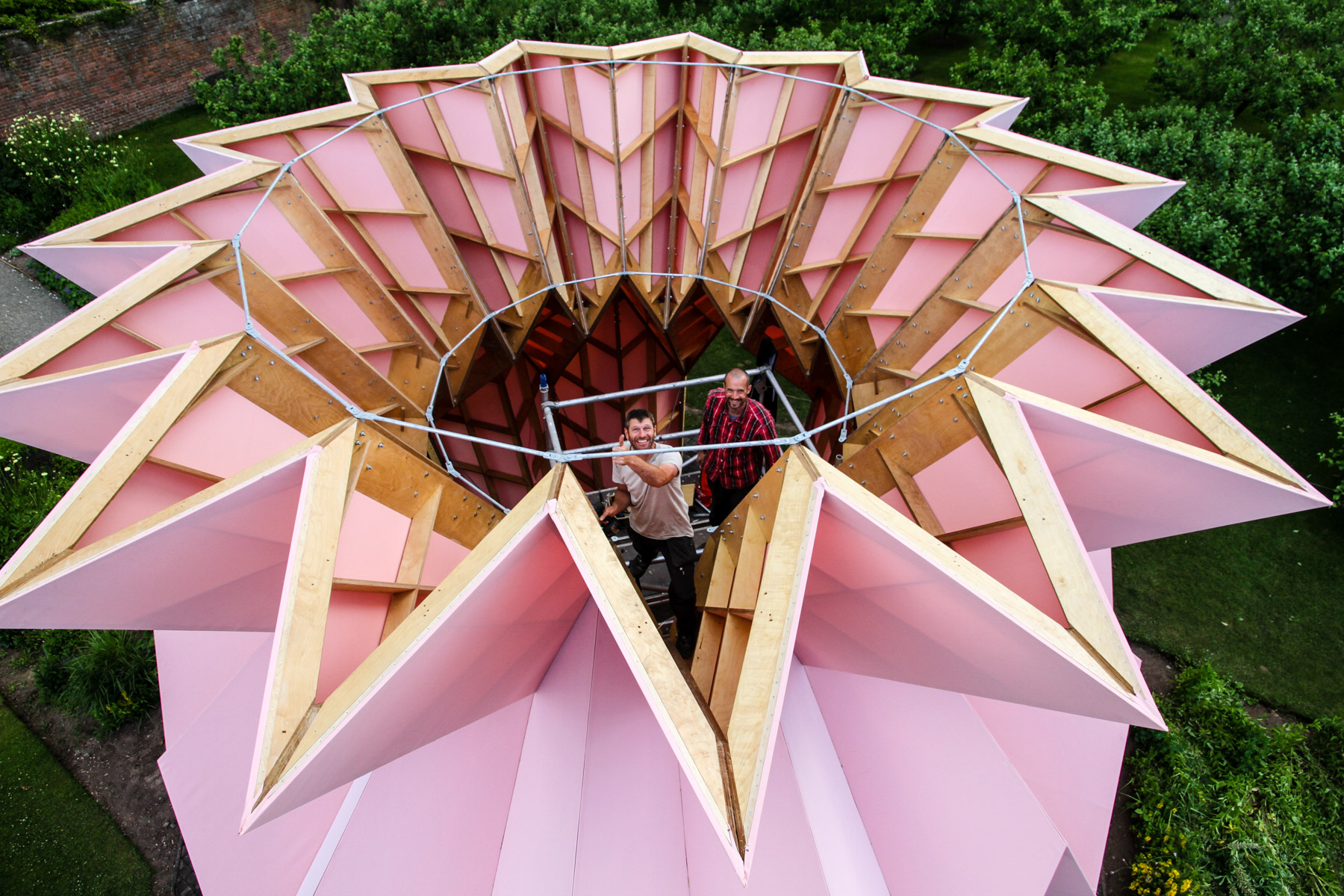
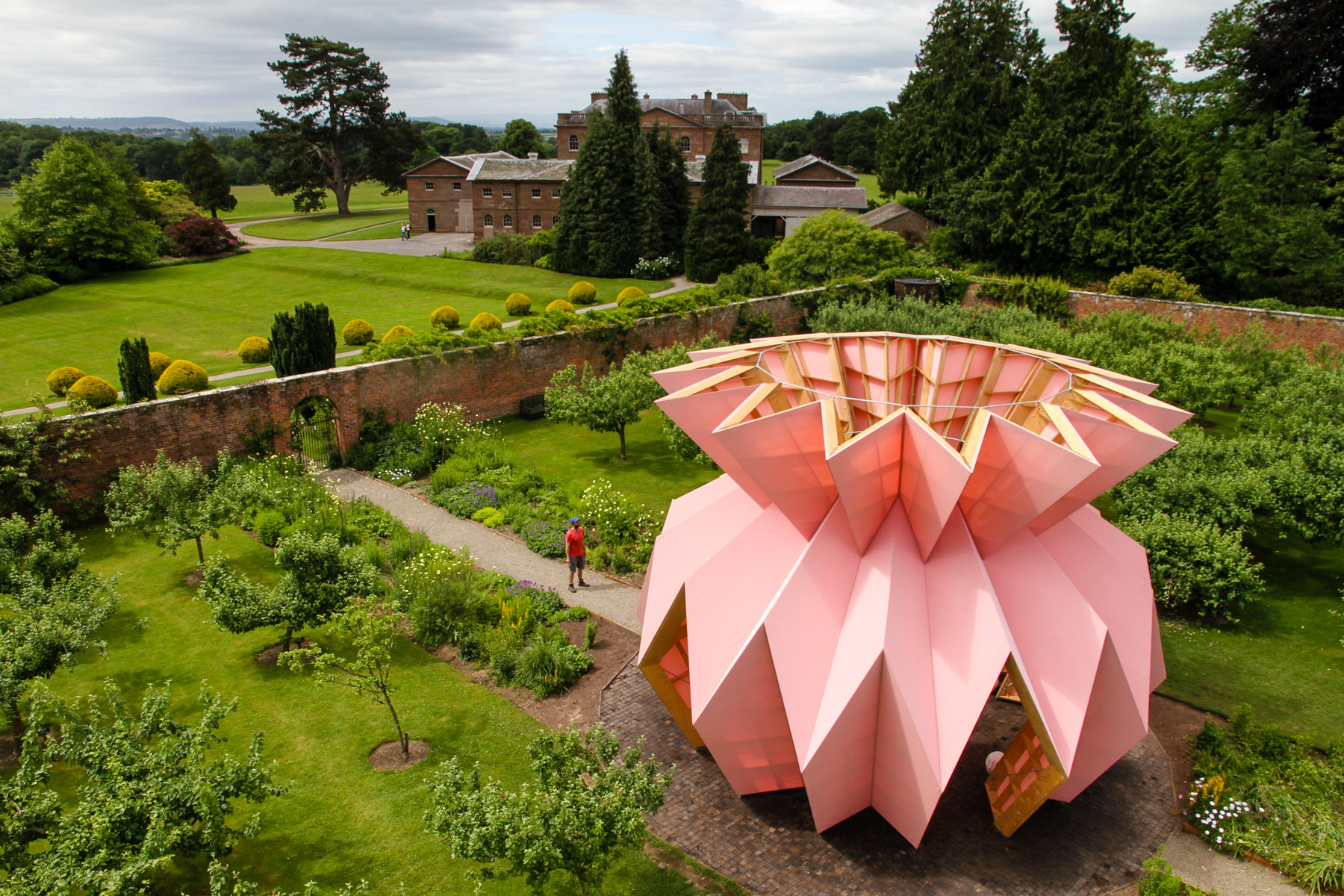

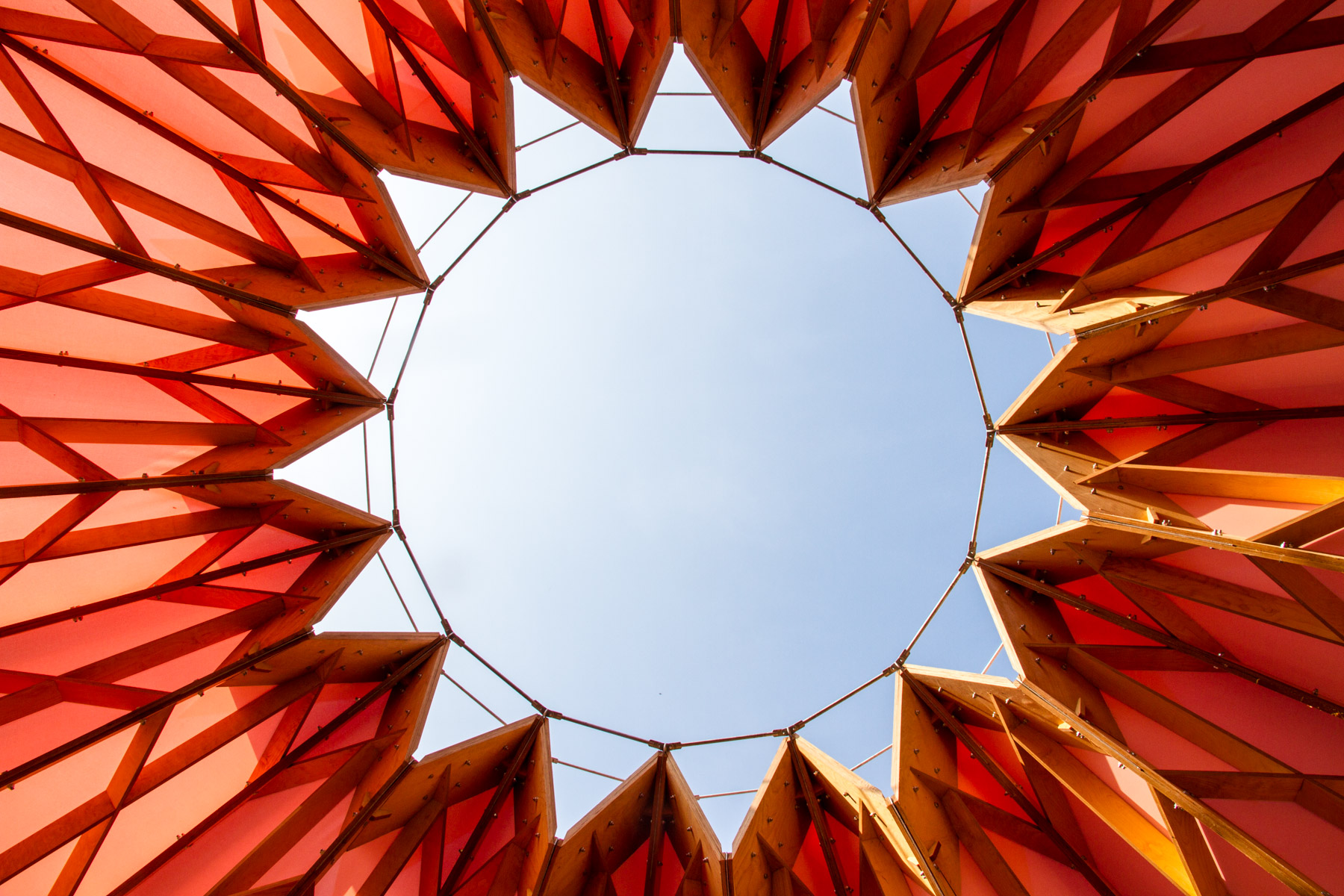
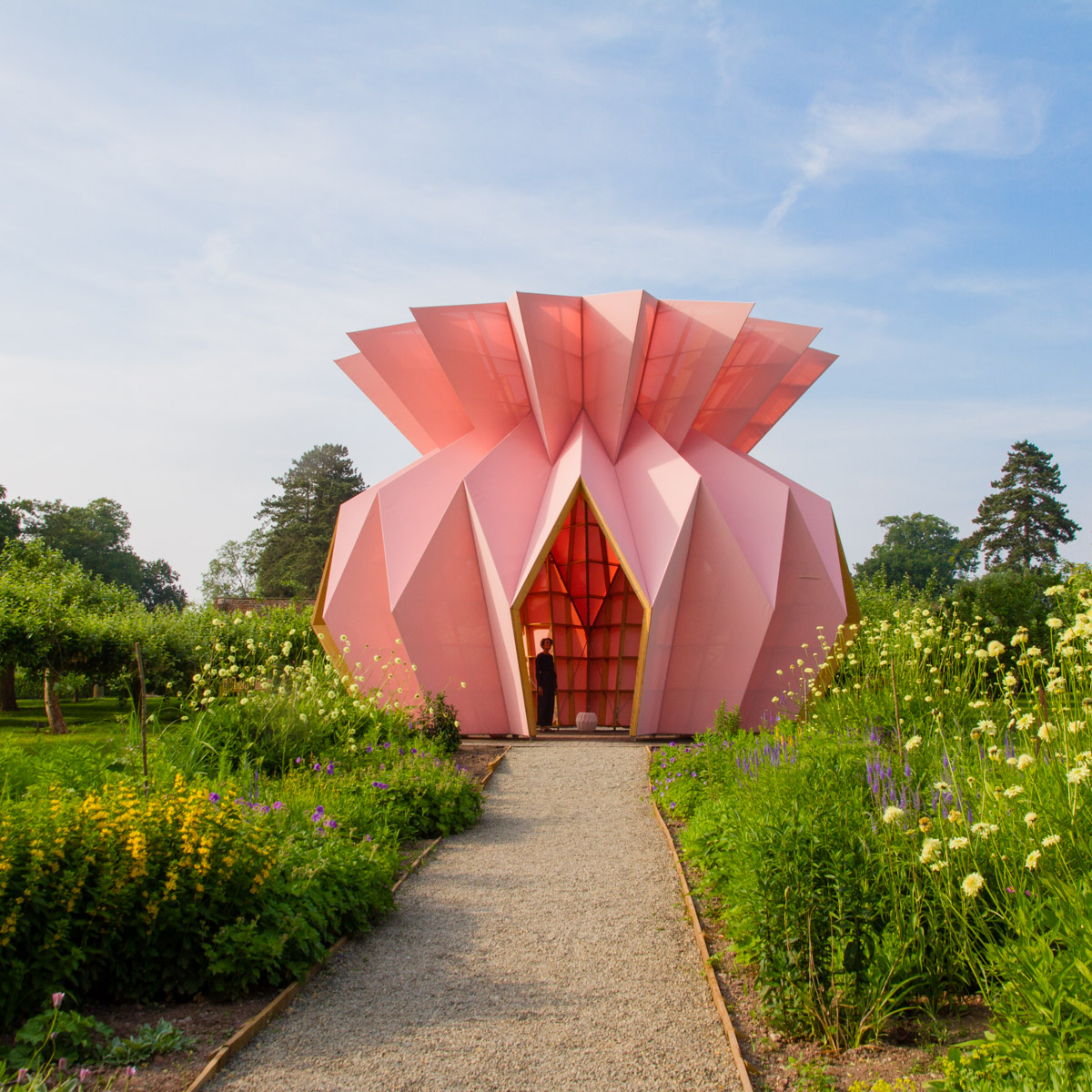
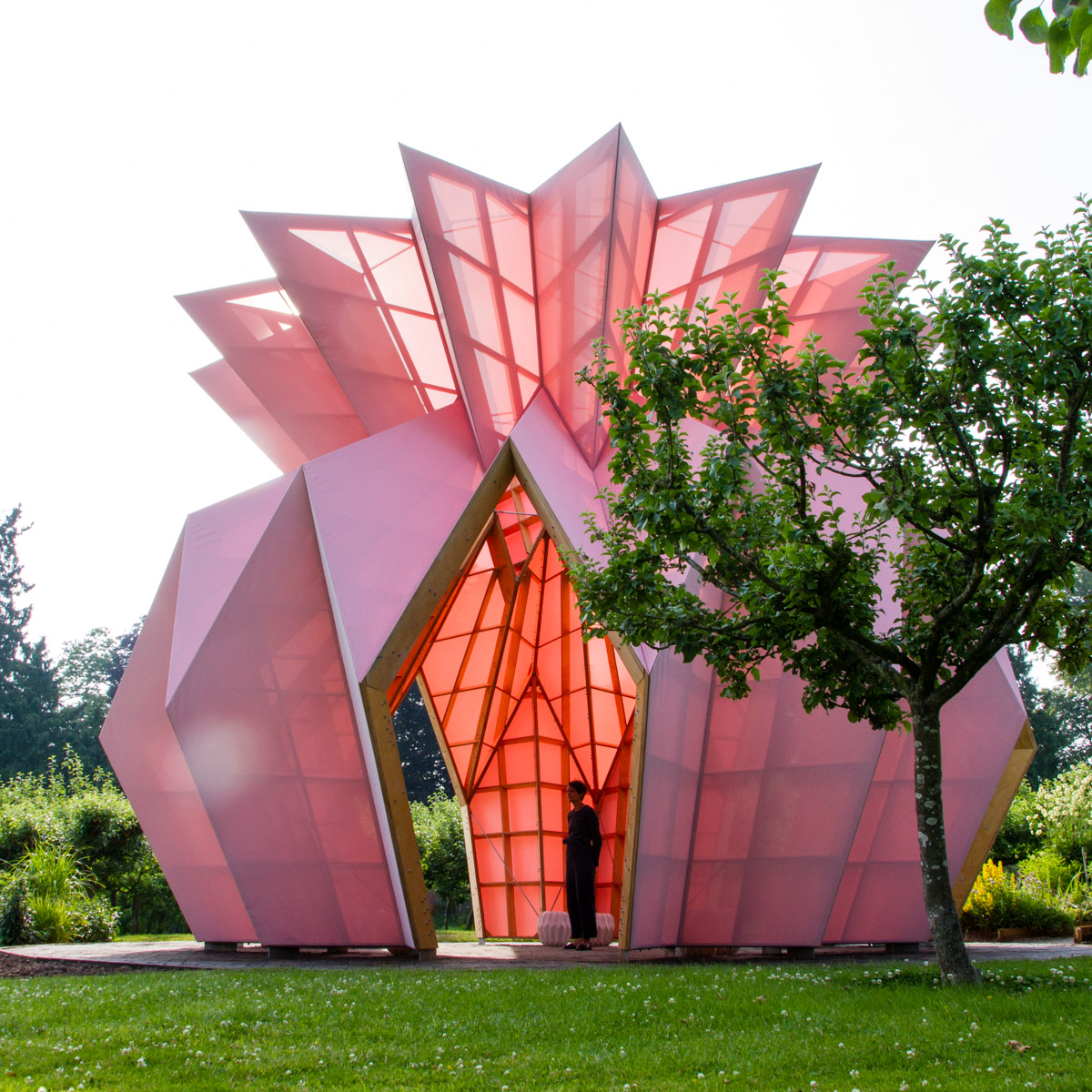
LOOK! LOOK! LOOK! is a pavilion enclosed within a walled garden designed by Georgian landscape designer Lancelot ‘Capability’ Brown. This was his final project, and his only walled garden. The Morisons wanted to create a contemporary folly, or ‘eye-catcher’, that often featured in eighteenth- and nineteenth-century landscaping. ‘We chose to make a pavilion, very much along the lines of the Georgian tented summer garden structures, to create a new temporary focus within the gardens, and to provide a space where new possible future activities and events could be held, tried, and tested. We wanted to take something as fundamental and simple as a rectangle of paper and fold it in such a way not just to give it structural stability, but also to make a sculptural form that created a notional sense of shelter, something that is fanciful and frivolous, that feels contemporary but also chimes with its Georgian surroundings.’
They designed the structure using origami, and then worked with structural engineers Artura to bring the concept to life. The metal foundation and timber structure is encased in a pink shell made from a special woven fabric, the body of which appears to have been folded into shape. The artists chose the striking colour from a Georgian palette found in the interior decor of Berrington Hall itself. The ‘gaudy yellow scagliola’ and the ‘dusty pinks’ present in the ceramics of the interior and its door surrounds provided the inspiration. They also drew their influence for the structural formation from the geometric shapes found inside the house – the repeated circular patterning on the stone floor and the same details on the scalloped ceiling – as well as the flowers within the garden. While referencing the hall’s interior, the shape also alludes to a pineapple – a happy coincidence, given that the estate grew pineapples in the eighteenth century. The artists also wanted the work to echo the Georgians’ social lives, and how they would have used their gardens. Among drinking and entertainment, this use would have included displaying the latest horticultural developments and scientific advances.
LOOK! LOOK! LOOK! remained in situ at Berrington Hall for three years. Grace Davies, the National Trust’s contemporary art programme manager, said of the work: ‘It was at once startling and exquisite; a joy to behold, bringing the whole estate to life, and in turn a wonder and delight to those who encountered it. The Morisons have the unique capability to take the spirit of the past and turn it into something magical for today.’
They designed the structure using origami, and then worked with structural engineers Artura to bring the concept to life. The metal foundation and timber structure is encased in a pink shell made from a special woven fabric, the body of which appears to have been folded into shape. The artists chose the striking colour from a Georgian palette found in the interior decor of Berrington Hall itself. The ‘gaudy yellow scagliola’ and the ‘dusty pinks’ present in the ceramics of the interior and its door surrounds provided the inspiration. They also drew their influence for the structural formation from the geometric shapes found inside the house – the repeated circular patterning on the stone floor and the same details on the scalloped ceiling – as well as the flowers within the garden. While referencing the hall’s interior, the shape also alludes to a pineapple – a happy coincidence, given that the estate grew pineapples in the eighteenth century. The artists also wanted the work to echo the Georgians’ social lives, and how they would have used their gardens. Among drinking and entertainment, this use would have included displaying the latest horticultural developments and scientific advances.
LOOK! LOOK! LOOK! remained in situ at Berrington Hall for three years. Grace Davies, the National Trust’s contemporary art programme manager, said of the work: ‘It was at once startling and exquisite; a joy to behold, bringing the whole estate to life, and in turn a wonder and delight to those who encountered it. The Morisons have the unique capability to take the spirit of the past and turn it into something magical for today.’
‘LOOK! LOOK! LOOK! is obscene in its boldness, impudent in colour, and audacious in its ability to carve up the sky;
its perfect and geometrically formed fronds break up the clouds and make the sky play second fiddle for once. This is sculpture in charge. Sitting squat and proud within
the genteel and predictable National Trust walled garden, this pavilion is at first glance the mohawk in church, the
mosh pit at the Proms, the safety pin not quite concealing the nipple. It is overly entitled garden sculpture, a riotmaker of garden design … and it’s clever. The simplicity of its design hoodwinks many of us into thinking this is just lazy provocation, agitation. Don’t be fooled. The pavilion is a storyteller, articulating the history of Berrington Hall and its gardens in a very contemporary way. It links tangibly with the wider estate and buildings, borrowing palettes and shapes and forms to give them a new and commanding voice, a voice fading within the context of the country-house-visit trope. To be within the walls of the pavilion is to render tangible the dichotomy of occupying space that is both private and public at the same time. The design allows for hiding and concealment – as many of our youngest,
and sometimes less young, visitors – have discovered, but also for being intruded upon or discovered (peals of delight or horror signify such events and occur in equal measure, mostly at weekends). Having had the privilege to see at first hand how the Morisons take a “can we really?” concept to “yes with bells on” reality, I have also had the privilege of being able to observe the sculpture within its unusual setting across four seasons, for two years. It is always beautiful, breathtaking, remarkable. LOOK! LOOK! LOOK! will no doubt have to go at some point. I feel a wrench at the thought of not being able to see it every day. It is only wood and canvas, I tell myself. But done properly, as achieved here, wood and canvas can be so much more; it makes you look at the world in different ways.’
Ellie Jones, Project Manager, National Trust
its perfect and geometrically formed fronds break up the clouds and make the sky play second fiddle for once. This is sculpture in charge. Sitting squat and proud within
the genteel and predictable National Trust walled garden, this pavilion is at first glance the mohawk in church, the
mosh pit at the Proms, the safety pin not quite concealing the nipple. It is overly entitled garden sculpture, a riotmaker of garden design … and it’s clever. The simplicity of its design hoodwinks many of us into thinking this is just lazy provocation, agitation. Don’t be fooled. The pavilion is a storyteller, articulating the history of Berrington Hall and its gardens in a very contemporary way. It links tangibly with the wider estate and buildings, borrowing palettes and shapes and forms to give them a new and commanding voice, a voice fading within the context of the country-house-visit trope. To be within the walls of the pavilion is to render tangible the dichotomy of occupying space that is both private and public at the same time. The design allows for hiding and concealment – as many of our youngest,
and sometimes less young, visitors – have discovered, but also for being intruded upon or discovered (peals of delight or horror signify such events and occur in equal measure, mostly at weekends). Having had the privilege to see at first hand how the Morisons take a “can we really?” concept to “yes with bells on” reality, I have also had the privilege of being able to observe the sculpture within its unusual setting across four seasons, for two years. It is always beautiful, breathtaking, remarkable. LOOK! LOOK! LOOK! will no doubt have to go at some point. I feel a wrench at the thought of not being able to see it every day. It is only wood and canvas, I tell myself. But done properly, as achieved here, wood and canvas can be so much more; it makes you look at the world in different ways.’
Ellie Jones, Project Manager, National Trust
Photographers’ credits
All images_ Ivan Morison
All images_ Ivan Morison